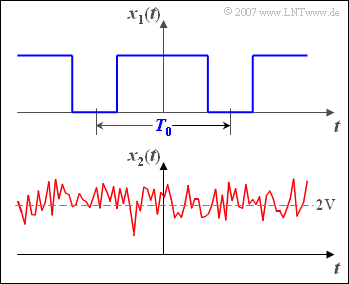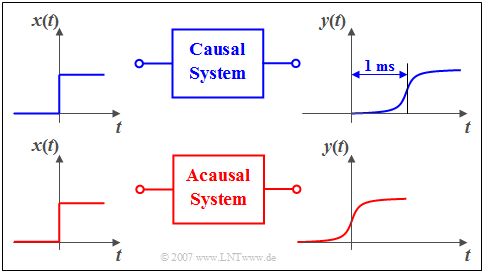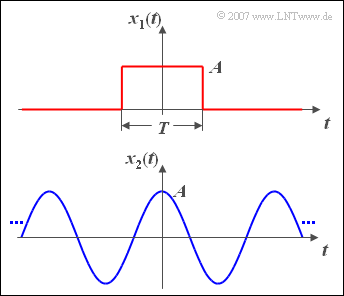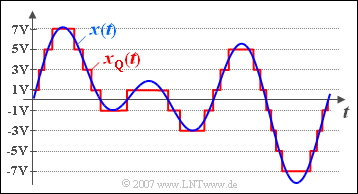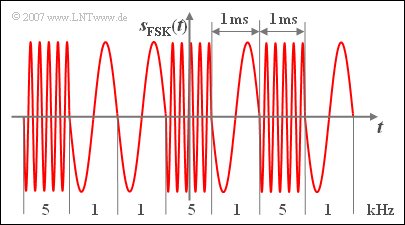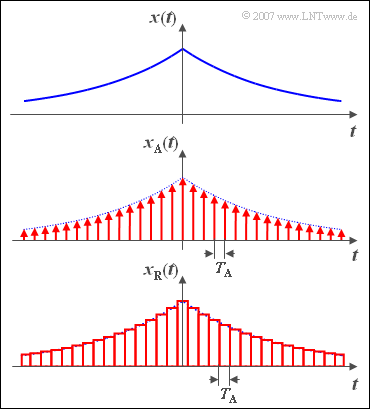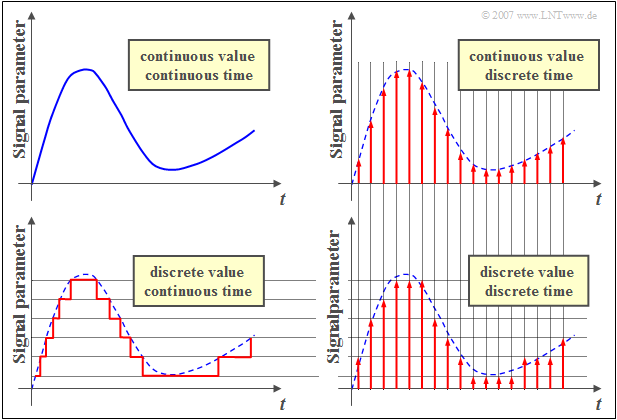Difference between revisions of "Signal Representation/Signal classification"
| Line 131: | Line 131: | ||
*Pulse-shaped signals like the signal $x_1(t)$ in the above example, energy is always limited. Mostly, the signal values here are different from zero only for a finite period of time. In other words: Such signals are often also time-limited. | *Pulse-shaped signals like the signal $x_1(t)$ in the above example, energy is always limited. Mostly, the signal values here are different from zero only for a finite period of time. In other words: Such signals are often also time-limited. | ||
| − | *But even signals that are unlimited in time can have a finite energy. In later [[Signal_Representation/Fouriertransformation_und_-rücktransformation|chapters]] you will find more information about energy limited and therefore aperiodic signals, for example the [[Signal_Representation/Einige_Sonderf%C3%A4lle_impulsartiger_Signale#Gau.C3.9Fimpuls|Gaussian pulse]] and the [[Aufgaben:3.1_Spektrum_des_Exponentialimpulses|Exponential pulse]] . | + | *But even signals that are unlimited in time can have a finite energy. In later [[Signal_Representation/Fouriertransformation_und_-rücktransformation|chapters]] you will find more information about energy limited and therefore aperiodic signals, for example the [[Signal_Representation/Einige_Sonderf%C3%A4lle_impulsartiger_Signale#Gau.C3.9Fimpuls|Gaussian pulse]] and the [[Aufgaben:3.1_Spektrum_des_Exponentialimpulses|Exponential pulse]] . |
{{BlaueBox|TEXT= | {{BlaueBox|TEXT= | ||
$\text{Definition:}$ | $\text{Definition:}$ | ||
| − | + | A signal $x(t)$ with finite power $P_x$ and accordingly infinite energy $(E_x \to \infty)$ is called '''power limited''.}} | |
| − | * | + | *All power limited signals are also infinitely extended in time. |
| − | * | + | *Examples are the [[Signal_Representation/Gleichsignal_-_Grenzfall_eines_periodischen_Signals|direct current signal]] and [[Signal_Representation/Harmonische_Schwingung|harmonic oscillations]] such as the cosine signal $x_2(t)$ in $\text{Example 3}$, which are described in detail in chapter [[Signal_Representation/Allgemeine_Beschreibung|Periodic Signals]]. |
| − | * | + | *Even most stochastic signals are power limited - see book [[Theory of Stochastic Signals]]. |
| − | == | + | ==Value-Continuous and Value-Discrete Signals== |
<br> | <br> | ||
{{BlaueBox|TEXT= | {{BlaueBox|TEXT= | ||
$\text{Definition:}$ | $\text{Definition:}$ | ||
| − | + | A signal is called '''value-continuous''', if the decisive signal-parameter - for example the instantaneous value - can take all values of a continuum (for example of an interval) . In contrast, if only countable many different values are possible for the signal parameter, then the signal is ''value-discrete''. The number of possible values is called the '''number of steps''' $M$ or the range of values.}} | |
| − | * | + | *Analog transmission systems always work with value-continuous signals. |
| − | * | + | *For digital systems, on the other hand, most but not all signals are value-discrete. |
| − | [[File:P_ID358_Sig_T_1_2_S4_a_neu.png|right|frame| | + | [[File:P_ID358_Sig_T_1_2_S4_a_neu.png|right|frame|Value-continuous and value-discrete signal]] |
{{GraueBox|TEXT= | {{GraueBox|TEXT= | ||
| − | $\text{ | + | $\text{Example 4:}$ |
| − | + | The upper image shows in blue a section of a continuous-value signal $x(t)$, which can take values between $\pm 8\ \rm V$ . | |
| − | *In | + | *In red color you can see the signal $M = 8$ quantization steps discretized on $x_{\rm Q}(t)$ with the possible signal values $\pm 1\ \rm V$, $\pm 3\ \rm V$, $\pm 5\ \rm V$ and $\pm 7\ \rm V$. |
| − | * | + | *For this signal $x_{\rm Q}(t)$ the instantaneous value was considered the decisive signal parameter. |
| − | [[File:P_ID831_Sig_T_1_2_S4_b_neu.png|left|frame|FSK-Signal - | + | [[File:P_ID831_Sig_T_1_2_S4_b_neu.png|left|frame|FSK-Signal - value-continuous and still binary]] |
| Line 173: | Line 173: | ||
| − | + | In an FSK system (''Frequency Shift Keying'') on the other hand, the instantaneous frequency is the essential signal parameter. | |
| − | + | Therefore the signal $s_{\rm FSK}(t)$ shown below is also called discrete with the step number $M = 2$ and the possible frequencies $1 \ \ \rm kHz$ and $5 \ \ \rm kHz$, although the instantaneous value is continuous in value.}} | |
Revision as of 22:15, 31 August 2020
Contents
Deterministic and Stochastic Signals
In every communication system both deterministic and stochastic signals occur.
$\text{Definition:}$ A deterministic signal exists, if its time functions $x(t)$ can be described completely in analytical form.
Since the time function $x(t)$ for all times $t$ is known and can be specified unambiguously, a spectral function $X(f)$ which can be calculated using the Fourier series or Fourier transform .
$\text{Definition:}$ One refers to a 'stochastic signal or to a random signal, if the signal course $x(t)$ is not - or at least not completely – describable in mathematical form. Such a signal cannot be predicted exactly for the future.
$\text{Example 1:}$ The graph shows time histories of a deterministic and a stochastic signal:
- At the top a periodic square wave signal $x_1(t)$ with period duration $T_0$ ⇒ deterministic signal,
- below a Gaussian noise signal $x_2(t)$ with the mean value $2\ \rm V $ ⇒ stochastic signal.
For such a non-deterministic signal $x_2(t)$ no spectral function $X_2(f)$ can be specified, since Fourier series/Fourier transform requires the exact knowledge of the time function for all times $t$
Information-carrying signals are always of stochastic nature. Their description as well as the definition of suitable parameters is given in the book Theory of Stochastic Signals.
However, the deterministic signals are also of great importance for communications engineering. Examples of this are:
- test signals for the design of communication systems,
- carrier signals for frequency multiplex systems, and
- a pulse for sampling an analog signal or for time regeneration of a digital signal.
Causal and Non-Causal Signals
In communications engineering one often reckons with temporally unlimited signals; the definition range of the signal then extends from $t = -\infty$ to $t=+\infty$.
In reality, however, there are no such signals, because every signal had to be switched on at some point. If one chooses - arbitrarily, but nevertheless meaningfully - the switch-on time $t = 0$, then one comes to the following classification:
$\text{Definition:}$ A signal $x(t)$ is called causal, if it does not exist for all times $t < 0$ or is identical zero. If this condition is not fulfilled, a ‘’non-causal signal (or system) exists.
In this book „Signal representation” mostly causal signals and systems are considered. This has the following reasons:
- Non-causal signals (and systems) are mathematically easier to handle than causal ones. For example, the spectral function can be determined here by means of Fourier transformations and one does not need extensive knowledge of function theory as in the Laplace transformation.
- Non-causal signals and systems describe the situation completely and correctly, if one ignores the problem of the switch-on process and is therefore only interested in the steady state .
The description of causal signals and systems using the Laplace Transform is shown in the book Linear Time-Invariant Systems.
$\text{Example 2:}$ You can see a causal transmission system in the upper graphic:
- If a unit step function $x(t)$ is applied to its input, then the output signal $y(t)$ can only increase from zero to its maximum value after time $t = 0$ .
- Otherwise the causal connection that the effect cannot begin before the cause would not be fulfilled.
The causality In the lower pictureis no longer given. As you can easily see in this example, an additional runtime of one millisecond is enough to change from the non-causal to the causal representation.
Energy Limited and Power Limited Signals
At this place first two important signal description quantities must be introduced, namely the energy and the power.
- In terms of physics, energy corresponds to work and has, for example, the unit "Ws".
- The power is defined as "work per time" and therefore has the unit "W".
According to the elementary laws of electrical engineering, both values are dependent on the resistance $R$ . In order to eliminate this dependency, the resistance $R=1 \,\Omega$ is often used as a basis in communications engineering. Then the following definitions apply:
$\text{Definition:}$ The energy of the signal $x(t)$ is to calculate as follows:
- $$E_x=\lim_{T_{\rm M}\to\infty} \int^{T_{\rm M}/2} _{-T_{\rm M}/2} x^2(t)\,{\rm d}t.$$
$\text{Definition:}$ To calculate the (mean) power , $T_{\rm M}$ must be divided by the timebefore the limit crossing:
- $$P_x = \lim_{T_{\rm M} \to \infty} \frac{1}{T_{\rm M} } \cdot \int^{T_{\rm M}/2} _{-T_{\rm M}/2} x^2(t)\,{\rm d}t.$$
Where $T_{\rm M}$ is the assumed measurement duration during which the signal is observed, symmetrically with respect to the time origin $(t = 0)$ . In general, this time interval must be chosen very large; ideally $T_{\rm M}$ should be towards infinity.
If $x(t)$ denotes a stress curve with the unit $\text{V}$, according to the above equations is for
- the signal energy the unit $\text{V}^2\text{s}$,
- the signal power the unit $\text{V}^2$.
This statement also means: In the above definitions the reference resistance $R=1\,\Omega$ is already implicit.
$\text{Example 3:}$ Now the energy and power of two exemplary signals are calculated.
The upper graphic shows a rectangular pulse $x_1(t)$ with amplitude $A$ and duration $T$.
- The signal energy of this pulse is $E_1 = A^2 \cdot T$.
- For the signal power, division by $T_{\rm M}$ and limit formation $(T_{\rm M} \to \infty)$ the value $P_1 = 0$.
For the cosine signal $x_2(t)$ with amplitude $A$ applies according to the sketch below:
- The signal power is equal to  regardless of the frequency; $P_2 = A^2/2$.
- The signal energy $E_2$ (integral over power for all times) is infinite.
With $A = 4 \ {\rm V}$ results for the power $P_2 = 8 \ {\rm V}^2$. With the resistance of $R = 50 \,\,\Omega$ this corresponds to the physical power ${8}/{50} \,\,{\rm V}\hspace{-0.1cm}/{\Omega}= 160\,\, {\rm mW}$.
According to this example there are the following classification characteristics:
$\text{Definition:}$ A signal $x(t)$ with finite energy $E_x$ and infinitely small power $(P_x = 0)$ is called energy limited.
- Pulse-shaped signals like the signal $x_1(t)$ in the above example, energy is always limited. Mostly, the signal values here are different from zero only for a finite period of time. In other words: Such signals are often also time-limited.
- But even signals that are unlimited in time can have a finite energy. In later chapters you will find more information about energy limited and therefore aperiodic signals, for example the Gaussian pulse and the Exponential pulse .
$\text{Definition:}$ A signal $x(t)$ with finite power $P_x$ and accordingly infinite energy $(E_x \to \infty)$ is called 'power limited.
- All power limited signals are also infinitely extended in time.
- Examples are the direct current signal and harmonic oscillations such as the cosine signal $x_2(t)$ in $\text{Example 3}$, which are described in detail in chapter Periodic Signals.
- Even most stochastic signals are power limited - see book Theory of Stochastic Signals.
Value-Continuous and Value-Discrete Signals
$\text{Definition:}$ A signal is called value-continuous, if the decisive signal-parameter - for example the instantaneous value - can take all values of a continuum (for example of an interval) . In contrast, if only countable many different values are possible for the signal parameter, then the signal is value-discrete. The number of possible values is called the number of steps $M$ or the range of values.
- Analog transmission systems always work with value-continuous signals.
- For digital systems, on the other hand, most but not all signals are value-discrete.
$\text{Example 4:}$ The upper image shows in blue a section of a continuous-value signal $x(t)$, which can take values between $\pm 8\ \rm V$ .
- In red color you can see the signal $M = 8$ quantization steps discretized on $x_{\rm Q}(t)$ with the possible signal values $\pm 1\ \rm V$, $\pm 3\ \rm V$, $\pm 5\ \rm V$ and $\pm 7\ \rm V$.
- For this signal $x_{\rm Q}(t)$ the instantaneous value was considered the decisive signal parameter.
In an FSK system (Frequency Shift Keying) on the other hand, the instantaneous frequency is the essential signal parameter.
Therefore the signal $s_{\rm FSK}(t)$ shown below is also called discrete with the step number $M = 2$ and the possible frequencies $1 \ \ \rm kHz$ and $5 \ \ \rm kHz$, although the instantaneous value is continuous in value.
Zeitkontinuierliche und zeitdiskrete Signale
Bei den bisher betrachteten Signalen war der Signalparameter zu jedem beliebigen Zeitpunkt definiert. Man spricht dann von einem zeitkontinuierlichen Signal.
$\text{Definition:}$ Bei einem zeitdiskreten Signal ist im Gegensatz dazu der Signalparameter nur zu den diskreten Zeitpunkten $t_\nu$ definiert, wobei man diese Zeitpunkte meist äquidistant wählt: $t_\nu = \nu \cdot T_{\rm A}$.
Da ein solches Signal beispielsweise durch Abtastung eines zeitkontinuierlichen Signals entsteht, bezeichnen wir $T_{\rm A}$ als den Abtastzeitabstand und dessen Kehrwert $f_{\rm A} = 1/T_{\rm A}$ als die Abtastfrequenz.
Weiter gilt:
- Ein zeitdiskretes Signal $x(t)$ ist durch die zeitliche Folge $\left \langle x_\nu \right \rangle$ seiner Abtastwerte vollständig bestimmt.
- Diese Abtastwerte können dabei sowohl wertkontinuierlich als auch wertdiskret sein.
- Die mathematische Beschreibung zeitdiskreter Signale erfolgt im Kapitel Zeitdiskrete Signaldarstellung.
$\text{Beispiel 5:}$ Das zeitdiskrete Signal $x_{\rm A}(t)$ erhält man nach Abtastung des oben dargestellten zeit- und wertkontinuierlichen Nachrichtensignals $x(t)$ im Abstand $T_{\rm A}$.
- Der unten skizzierte Zeitverlauf $x_{\rm R}(t)$ unterscheidet sich von der echten zeitdiskreten Darstellung $x_{\rm A}(t)$ dadurch, dass die unendlich schmalen Abtastwerte (mathematisch mit Diracimpulsen beschreibbar) durch Rechteckimpulse der Dauer $T_{\rm A}$ ersetzt sind.
- Ein solches Signal kann nach obiger Definition ebenfalls als zeitdiskret bezeichnet werden.
Analogsignale und Digitalsignale
$\text{Beispiel 6:}$ In der Grafik sind an einem Beispiel die folgenden Signaleigenschaften verdeutlicht:
- „wertkontinuierlich” und „wertdiskret”, sowie
- „zeitkontinuierlich” und „zeitdiskret”.
Daneben gelten noch folgende Festlegungen:
$\text{Definition:}$ Ist ein Signal sowohl wert– als auch zeitkontinuierlich, so spricht man auch von einem Analogsignal. Solche Signale bilden einen kontinuierlichen Vorgang kontinuierlich ab. Beispiele hierfür sind Sprach–, Musik–, Bild– und Mess Signale.
$\text{Definition:}$ Ein Digitalsignal ist dagegen stets wert– und zeitdiskret und die darin enthaltene Nachricht besteht aus den Symbolen eines Symbolvorrats. Es kann beispielsweise ein abgetastetes und quantisiertes (sowie in irgendeiner Form codiertes) Sprach–, Musik– oder Bildsignal sein, aber auch ein Datensignal, wenn im Internet eine Datei von einem Server heruntergeladen wird.
Je nach Stufenzahl sind Digitalsignale auch noch unter anderen Namen bekannt, beispielsweise
- mit $M = 2$: binäres Digitalsignal oder Binärsignal,
- mit $M = 3$: ternäres Digitalsignal oder Ternärsignal,
- mit $M = 4$: quaternäres Digitalsignal oder Quaternärsignal.
Das Lernvideo Analoge und digitale Signale fasst die in diesem Kapitel behandelten Klassifizierungsmerkmale in kompakter Weise zusammen.
Aufgaben zum Kapitel
Aufgabe 1.2: Signalklassifizierung
Aufgabe 1.2Z: Pulscodemodulation
